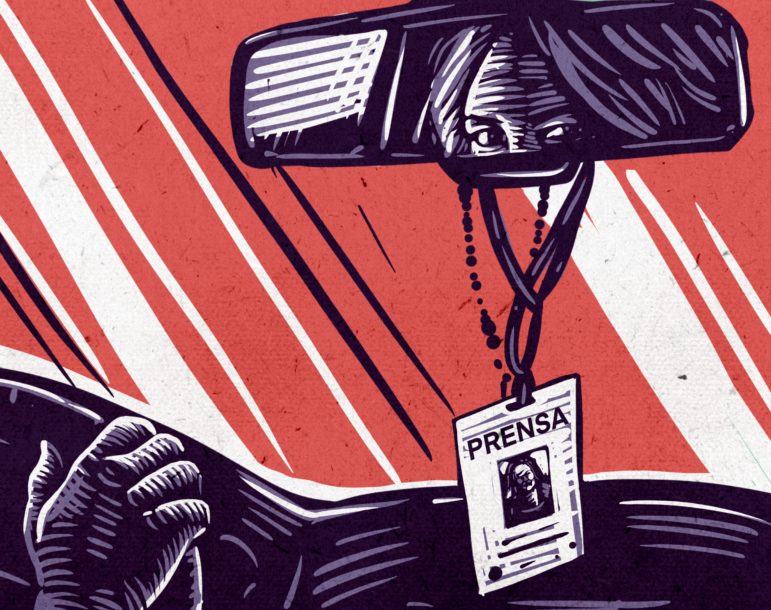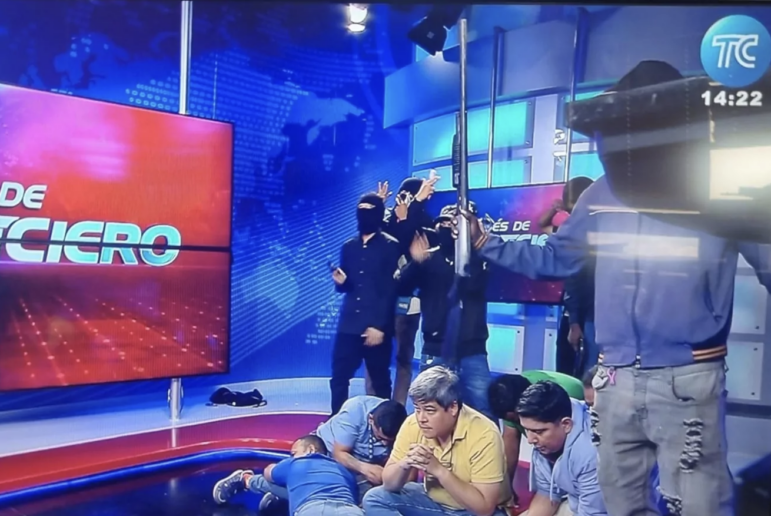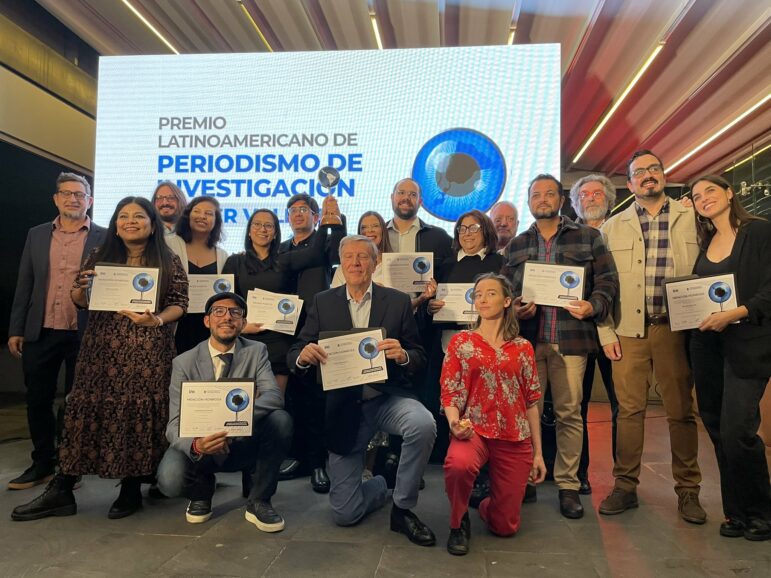

Illustration: Dante Aguilera
Fixer or Collaborator? Tips for Hiring Local Reporters
Read this article in

One of several original illustrations in the Fixing Journalism guide from Frontline Freelance Mexico. Illustration: Dante Aguilera
A few years ago, Alicia Fernández, a multimedia journalist in Ciudad Juárez, Mexico, arranged an interview with a cartel drug dealer for a Western investigative journalist. She used cultivated relationships and careful planning for that access, while protecting her client’s ethics by offering no incentives for the meeting. The Western reporter then demanded a second interview.
“I told him I could not do that,” Fernández recounted recently. “He took a $100 bill and waved it in front of me as if I was a starving dog. I dropped the bill in his drink.”
Another local journalist, Jesús Bustamente, has similar stories about providing investigative access to a foreign media crew in the Sinaloa region: “They said: ‘We have a few free hours – do you think we can go visit a fentanyl lab?’”
The Western journalism community in general is currently rethinking how it treats local journalist collaborators – widely known either as “fixers” or local producers — in conflict zones and the Global South, as freelance journalist Laura Oliver explained in a recent piece for the Reuters Institute.
Many local reporters point to a general lack of respect, insufficient remuneration, and disregard for safety – and even take issue with the word fixer itself – from newsrooms doing field reporting in remote areas and hostile environment zones overseas. Five years ago, a survey of 450 correspondents and logistical support staff, conducted by the Global Reporting Centre, revealed that local reporting partners typically face greater risks on stories, yet receive much less editorial influence and credit – especially reporters of color.
One nonprofit group, Frontline Freelance Mexico (FFM), has produced a guide on how Western outlets should treat these journalists in conflict, news, and investigative stories. FFM plans to launch the guide formally in November 2022, including a dedicated website, as part of its broader “Fixing Journalism” project.
Notably, however, FFM – whose members include 250 freelance journalists in Mexico – does not object either to the fixer label or its role, per se. Indeed, they have trained dozens of journalists in both fixer and producing roles in the past two years.
Instead, the guide encourages outlets, above all, to treat local reporters as professional collaborators, rather than unpaid media industry sources or taxi drivers. It also defines the difference between fixer and producer/stringer roles, and asks client newsrooms to contract journalists based on their defined project contributions, and then offer the proper credit, pay, and trust.
Based on interviews with 30 local Mexican journalists – like those with Fernández and Bustamente – the guide points out that reporters hired as fixers have played crucial journalistic roles in such investigations as femicide in the border city of Ciudad Juárez, the infamous kidnapping of 43 students from Ayotzinapa by Mexican police, and violence facing migrants and asylum seekers.
“In two or three days’ work purely as a fixer, local reporters can earn what they otherwise make in a month as freelancers, given the miserable pay in Mexico,” notes Andalusia Soloff, co-founder of FFM. “I personally don’t like the fixer label, but many are OK with it, and even work that meets the basic fixer definition does help with sustainability. But we would prefer that clients consider elevating their role to collaborators, and fully credit them, to make their journalistic contributions visible, to ensure their input is heard, and to make them eligible for things like journalism prize money.”
Soloff said the project began in 2019, when testimonies from a freelance workshop in Mexico City suggested that the majority of rural freelancers in Mexico have worked as fixers – most, without credit, and some, she says, without even realizing they had performed a professional journalism service.
“International journalists often come across local stories by the local reporter, and come to their town, and invite them to a coffee – where they get all their contacts and guidance,” she explains. “Mexican culture is very generous, and it is common for local reporters to share their own, carefully cultivated sources if asked, and their goodwill is basically exploited.”
Lenin Mosso, a documentary photographer in the southern Mexican state of Guerrero, is quoted in the guide offering a harrowing example of the risks local partners often take. “I contacted a hitman. When I met with him at a store to propose the interview, I realized I was putting my life at risk to achieve the story they wanted,” he recounted, referring to the reporters who hired him. “I told them: ‘If anything [bad] happens, he knows where I live.”
While the definitions of roles may not be crucial in themselves, Soloff says it’s important for client newsrooms to think about the tasks these journalists perform – and the expertise they bring to projects – to credit and pay them properly. According to the guide:
- In general, ‘fixer’ tasks may include translation, security recommendations, access to reporting sites, logistical help, and arranging interviews with sources pre-identified by the client.
- However, local reporters should be credited and paid as a producer or bylined correspondent – and qualified for any journalism prizes that may follow – if (1) those arranged interviews involve their own sources or recommended sources; or (2) they assist with story angles; or (3) they conduct a risk assessment; or (4) they supply photographic, video, or drone imagery; or (5) they conduct any interviews, or (6) they coordinate the reporting team.
- Local partners on follow-ups and deep-dive investigations should be fully credited. Local collaborators are often identified through online searches of bylines on their prior stories – and foreign outlets sometimes ask these reporters to help them to effectively reproduce, or expand upon, these investigations. In these cases, FFM encourages Western outlets to fully credit the local reporters, and attribute their prior work, no matter what their role in the collaboration.
How Local Journalists Enrich Western Investigations
“I was hired by a European TV journalist who looked at all my stories in a year, and said: ‘I want to do every story you did in one month,” Soloff recalls. “He didn’t know the context or the contacts, or where to go, and wanted my help. I explained: ‘That’s not a fixer, that’s a producer.’ While I was then hired as a local producer, I was still not named in the TV reports that got two awards in Europe.”
She adds: “Because they are in the daily grind, local journalists often don’t have the time or resources to fully investigate a story they uncover. But they found the lead. So when a foreign journalist comes to dig deeper, they should treat the local reporter as a full, bylined partner on the story, not just a fixer. Numerous times, we find that foreign journalists get awards for local revelations.”
While their contributions to conflict and disaster reporting are better known, Soloff says fixers and local producers invariably improve access, safety, diversity, and contextual accuracy for accountability stories and investigative documentaries in the Global South.
“Local journalists have a much deeper knowledge of their context, and have carefully cultivated relationships, and including them in your story as a partner – not just as a fixer – will always enrich your foreign investigation,” she explains. “Also, when we look at diversity in Western outlets, there is often little input from people of color, or people from the Global South, and involving local reporters as collaborators is the easiest way to address this issue.”
In a session on impactful investigative reporting in the Asia/Pacific region at the 12th Global Investigative Journalism Conference (#GIJC21), Pakistani journalist Shah Meer Baloch also explained how local reporter collaborators can provide crucial help to undercover reporting projects in remote areas – such as his piece on brutal labor abuses in some of Pakistan’s coal mines. “They know where to take you for your story and how to escape when you are being tracked,” Baloch told the audience.
Frontline Freelance Mexico has also hosted freelance workshops to help local reporters pitch themselves to foreign outlets, such as one module titled “How to change local angles to make it an international story.”
Soloff says travel restrictions from the COVID-19 pandemic helped to “open the eyes” of many Western newsrooms to the fact that local reporters previously seen only as fixers could produce commissioned investigations on their own.
“I moved up from being a fixer to being a directing producer because the people I used to work under couldn’t travel anymore, and clients realized, ‘Oh, she can do everything; she can do it without us,’” she says. “Many others had the same experience.”
Some tips on collaborating with local reporters from the Frontline Freelance Mexico Guide:
- If your local reporting partner has been forced to agree to source anonymity or blurred faces in images, it is crucial – for reasons of both safety and ethics – that outlets honor those agreements in the published story. It is recommended that both producers and fixers be shown drafts of sensitive stories ahead of publication and that their input be considered.
- Recognize you may need to rely on other communications channels to reach local reporters. “Freelancers just don’t use email here – forget it,” Soloff notes of working with local reporting partners in Mexico. “Outlets get in touch largely through phone contacts from word-of-mouth, or through social networks and message boards, or through freelancer sites like Storyhunter, or via their bylines on issues the outlets are interested in.”
- Don’t treat local reporters as unpaid sources at story orientation meetings – and don’t seek their investigative contacts in exchange for supplying coffee or a meal. Instead, offer to pay them as professionals for their access services – at the very least – or otherwise as investigative project partners.
- Pay a reasonable rate that takes into account much of the unseen work local partners do. For, example, in Mexico, fixers doing specific tasks should never be offered less than $150 per day for nine-hour days. Outside outlets should also cover any additional expenses and insurance if they use a local partner’s vehicle or other resources.
- Always leave more time than you think you will need to report – and be patient in rural investigations. FFM’s guide states that “in rural areas, the rhythm of life is much slower.”
- Use the perspectives of local reporters to avoid stereotyping in investigations. In Mexico, this means going beyond a clichéd narrative “simplifying the violence to a Wild Western with warring narcos, hooded hitmen, and good politicians arresting kingpins.”
- Continue the dialogue with local partners after you leave town. This includes inviting input into the finalized story draft – or, at minimum, alerting them to the publication date – and alerting them to any journalism awards, and discussing their share in any prize money.
Soloff warns that racial discrimination persists in local journalist hiring in the Global South: “If you’re a brown local journalist, you’re typically seen by Western newsrooms as a fixer; if you’re a light-skinned local journalist, you’re generally seen as a correspondent.”
Trust in Local Collaborators Is Key
Ultimately, Soloff says an attitude of respect for local reporters as fellow journalists is the central feature that unlocks most benefits of the collaboration, including more safety, better interviews, deeper diversity, and greater transparency for audiences. Trust-related tips in the guide include these:
- Allow the local collaborators to lead sensitive discussions. “While it may seem the fixer is wasting time making small talk before an interview, it is likely they are helping the source feel comfortable.” In many cultures, like in Mexico, politeness and patience play a key role in building trust with reluctant sources.
- Avoid any cancellation of interviews arranged with victims, who are often reliving personal trauma each time they tell their story. FFM’s guide states: “When the fixer or producer sets up an interview with one of these victims, it is important to not cancel unless an absolute emergency comes up… It is important that you don’t re-victimize people.
- Accept the realities of organized crime access. “Many fixers have been able to cultivate relationships with criminal elements – but it is important to understand that the people within the criminal world are the ones that call the shots,” the guide notes.
- Trust local collaborators on safety decisions. Says Soloff: “Fixers tell us their clients sometimes ignore their advice on safety, and say stuff like: ‘Oh I see children playing in the street, so I think you’re wrong – it must be safe to go there.’”
Soloff hopes to hold workshops for fixers and local producers in other parts of Latin America and Southern Africa, in collaboration with local freelancers, and to highlight their potential, deeper contributions to client newsrooms.
“There is a need to shift the dynamic across the Global South,” she says.
Additional Resources
How Quinto Elemento Trains Mexico’s New Generation of Muckrakers
Fixing the Journalist-Fixer Relationship
Video for Small Newsrooms & Freelancers
 Rowan Philp is GIJN’s senior reporter. He was formerly chief reporter for South Africa’s Sunday Times. As a foreign correspondent, he has reported on news, politics, corruption, and conflict from more than two dozen countries around the world.
Rowan Philp is GIJN’s senior reporter. He was formerly chief reporter for South Africa’s Sunday Times. As a foreign correspondent, he has reported on news, politics, corruption, and conflict from more than two dozen countries around the world.










